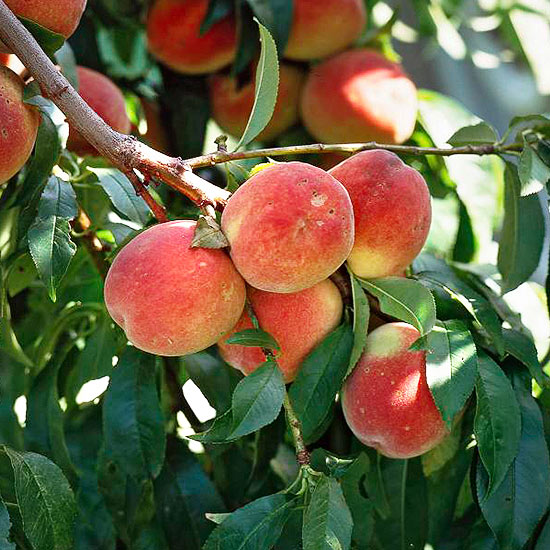






Peaches fresh from the garden: It's the perfect picture of summer. Can't you just feel the juice running down your chin? It's perfectly reasonable to think you can learn how to grow peaches in USDA Zones 5-9. Pick the right peach and the right place, and give the tree the right care, and you'll be picking ripe fruit in just a year or two.
Grow Peaches in the Right Spot
The trees do best in a spot with full sun -- at least 6 hours per day, and good air flow.
Because grass is greedy, it will suck up moisture and nutrients from the soil around the tree. Keep the ground around the trunk free of grass for at least the first few years. Putting a 2-inch-deep ring of mulch around your tree will help the soil stay moist during periods of drought and keep your peach tree's trunk safe from lawn mower or string trimmer damage. Yearly applications of a dry organic fertilizer for fruit trees will help keep your peach tree healthy; follow directions on the package.
Peaches like it hot, so if you live in a cool-summer region, choose the warmest place in your garden. That's most likely up against a south-facing wall, where the tree will receive radiated heat and reflected light. Often these spots are in narrow planting beds -- between a walk and the garage wall, for example -- so you may want to grow peaches in an espaliered style, where the branches are trained in a two-dimensional fashion. Get creative and train the tree in a fan or candelabra form.
Learn more about espalier.
Most peach varieties are grown on another kind of peach's roots. This gives them extra hardiness and disease resistance, or makes them a smaller, more compact plant. The graft, where the two different plants meet, looks like an old scar. Be sure to plant your peach tree so the bud union -- the place where the trunk was grafted onto rootstock -- is about an inch above the soil line. Covering that graft can cause problems, so be sure the tree trunk doesn't sink over time. One way to prevent this is to plant the tree 2 to 3 inches higher than soil level.
The best peaches for cool-weather regions include 'Frost' and 'Avalon Pride'. Wondering how to grow peaches on your deck or patio? Take a look at dwarf selections including 'Pix-Zee' and 'Honey Babe'; those trees reach only about 6 feet tall and will grow in large pots.
Have you ever stuck toothpicks into an avocado seed and put it in water? It's a great science experiment -- and an easy houseplant for a college dorm room. You might be tempted to grow your own peach tree, too, with the goal of getting a really cheap orchard tree.
Go ahead and plant that peach pit -- the almond-shape seed inside the big pit -- and in five to seven years, you can actually get fruit. But it probably won't taste like the kind you planted. Peach varieties are special selections propagated by taking cuttings of branches; that way the fruit is always the same. Seeds contain genetic material from two different parents (mom and dad), and you know how it is with children -- you never know what you'll get.
Proper pruning is an important part of how to grow peaches -- and that includes timing as well as technique. Prune peaches in late winter but before spring bloom. Aim to establish an open canopy so sunlight can reach all of the fruit; too much shade can reduce the number of flowers produced, and that means fewer fruits -- which leads to fewer servings of peach cobbler. All pruning starts by taking out dead, broken, or dying branches first, and then removing branches that cross. Just doing that will reduce congestion and open up the tree.
Peaches produce flowers and fruit on wood that grew last year. The best branches to keep will be about as thick as a pencil and no more than 18 inches long -- longer stems can be cut back to an upward-facing bud. Yearly pruning helps your tree, so don't be afraid to get in there with a sharp bypass pruner.
Peaches are not without their problems, but when you dream of sinking your teeth into a fresh peach or enjoying peach jam through the winter, you won't mind dealing with potential pests and diseases.
Peach leaf curl is the nemesis of many a home gardener, although other fungal problems may exist, such as brown rot. Although many cultivars are resistant to peach leaf curl, your tree may still get this foliar disease, especially when it's young. Often, as trees mature, they grow out of the disease. But the best offense is a good defense, so take steps now to minimize the problem.
Here's how to grow peaches that are disease-free: use a lime-sulfur spray, which is approved for organic growers. The timing of the spray is important -- it needs to be applied at specific intervals in the tree's budding out, so read the label on the product carefully.
Copyright © www.100flowers.win Botanic Garden All Rights Reserved